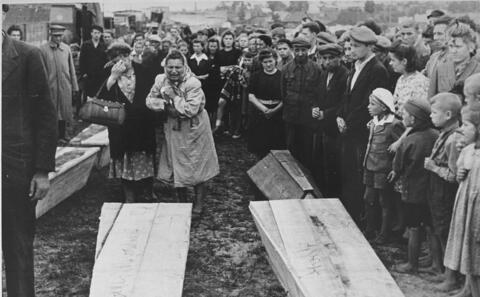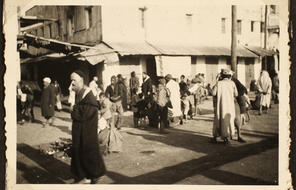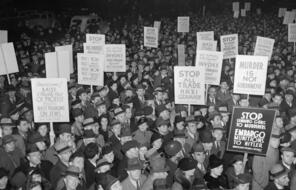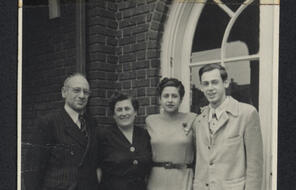The Persistence of Antisemitism
Subject
- History
- Social Studies
Language
English — USUpdated
Antisemitism after Liberation
Within a few months of the end of the World War II, most people believed that in fact 6 million Jews had been murdered by Nazi Germany. 1 But the extraordinary violence that we now know as the Holocaust did not put an end to antisemitism in Europe.
Emil Draitser was born in Odessa, a city in Ukraine then under Soviet rule, just before the war. In 1945, when he and his mother returned from Uzbekistan (where they had hidden from the Germans), they quickly discovered that “the war was still giving off smoke in the hearts of those children who had grown up in it.” Draitser wrote:
For a long time after the war ended, in the quiet corners of Odessa streets, in the remote alleys of the parks, in the secluded places among the ruins, gangs of youngsters hunted for Jewish kids, survivors of the Holocaust, and harassed and beat them up, often till they bled. 2
Antisemitism affected the way Jews were treated almost everywhere after the war, but feelings against Jews were especially strong in Poland. In the months after the war ended, more than 350 Jews were murdered there, and countless others were assaulted. Tensions between Polish Jews and non-Jewish Poles intensified after the Soviet Union, which had liberated Poland from the Germans, established a Communist government there. Poles increasingly saw themselves as victims of violence and oppression, first at the hands of the Nazis and now at the hands of the Soviets.
Concerned by the growing antisemitism in Poland, Joseph Tenenbaum, the president of the American-based World Federation of Polish Jews, met in June 1946 with Cardinal August Hlond, the head of the nation’s Catholic Church. Tenenbaum hoped to persuade the cardinal to take action to stop the violence. The cardinal refused. He insisted that Jews were being killed in retaliation for “the murder of the Christian population by the Jewish Communist-run Polish Government.” 3 This was just one example of the old stereotype of Jews as communists, which took on new life after the war as the Union of Soviet Socialist Republics (USSR) extended its influence over unwilling eastern European populations.
- 1Tony Judt, Postwar: A History of Europe Since 1945 (New York: Penguin Press, 2005), 804.
- 2Emil Draitser, Shush! Growing Up Jewish under Stalin: A Memoir (Berkeley: University of California Press, 2008), 16.
- 3Joseph Tenenbaum, In Search of a Lost People: The Old and the New Poland (New York: Beechhurst Press, 1948), 238.
Mourners after Antisemitic Rampage in Poland

Mourners after Antisemitic Rampage in Poland
Mourners in Kielce, Poland, gather around coffins after townspeople killed 42 Jews in an antisemitic rampage in 1946.
The need to help Polish Jews took on new urgency in July 1946. An eight-year-old boy in Kielce, a small city 120 miles south of Warsaw, had gone to visit friends in a nearby village without telling his family. His worried parents reported his disappearance to the police, and when he returned two days later, his father claimed that the boy had been kidnapped by Jews but had escaped. Soon, a rumor spread that other Christian children had been kidnapped and murdered. 4 Within hours, more than 1,000 angry protesters had surrounded a building owned by the Jewish community in Kielce and attacked every Jew inside. When the rampage ended, about 75 Jews were injured and 42 were dead, including a number of children. 5 Police officers and soldiers had both been on the scene, but none of them tried to stop the violence.
What caused the post-war violence against Jews, like the rampage in Kielce? Some think it arose from Poles’ sense of guilt—for turning a blind eye to the murder of their neighbors, for helping the Germans, or for taking the belongings that Jews had left in their safekeeping. Some say it grew out of a long habit of antisemitism that predated Nazism by centuries. Others believe it was caused by fear that Jewish survivors would seek revenge on those who had betrayed them.
Even after such violence, many Europeans did not see Jews as worthy of special protection. Although they could not help knowing about the murder of millions of Jews, a consciousness of the significance of the Holocaust—and even the use of the term “Holocaust” itself—would not emerge for decades. Jewish victims were subsumed into other national groups or such categories as “political deportees” or “victims of fascism,” if they were acknowledged at all. Most Europeans simply wanted to forget the years of the war and move on with their lives.
So, as historian Tony Judt writes,
After Germany’s defeat, many Jews in Eastern Europe pursued their wartime survival strategy: hiding their Jewish identity from their colleagues, their neighbors and even their children, blending as best they could into the post-war world and resuming at least the appearance of normal life. And not only in Eastern Europe. In France . . . taboos [against antisemitism] of a later generation had not yet taken hold, and behavior that would in time be frowned upon was still acceptable . . . In these circumstances, the choice for most of Europe’s Jews seemed stark: depart (for Israel once it came into existence, or America after its doors were opened in 1950) or else be silent and, so far as possible, invisible. 6
Connection Questions
- How does this reading connect with the history you’ve already studied? In what ways does it surprise you or challenge your thinking?
- Why do you think old myths, stereotypes, and hatred of Jews persisted after World War II, even after the Nazis were defeated and their ideas discredited?
- In what ways might post-war life in Europe have activated antisemitism?
- What choices did Jewish survivors face during this period? What options might have been available to them when they were confronted with antisemitism? Why might they have chosen not to identify themselves as Jews and as survivors?
How to Cite This Reading
Facing History & Ourselves, “The Persistence of Antisemitism”, last updated August 2, 2016.













